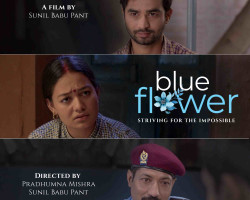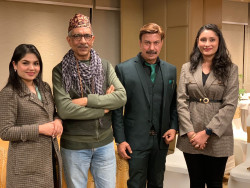Kollywood
Prakash is a terrific visual representation and when the movie ends thoughts begin to rush through an audience's mind. Filmed in and around Jumla's rural settings, Prakash brings a story of the struggle of a mother and her adult son to break the vicious cycle of poverty. Prakash is a treat to your eyes and a bolt on your conscience. All elements that go into the making of a great movie - visuals, emotions, characters, props, shots, music and sound - complement each other seamlessly to produce a unique visual experience.
The Plot
Though its name is Prakash, meaning light, there is no flicker of hope for the mother and son who represent millions of Nepalis across Nepal, especially those living in the far-flung remote hills of Nepal. This has been reinforced by the impeccable camera work that has captured shots in dark, or in low light. The film starts with a funeral procession and ends with another. It portrays a hopeless end of a dream, and a dreamer.
Prakash is a dreamer. So, is his mother, Sita. She, along with her son, had a dream that her disappeared husband would return, that her son would get married, that he would one day become a teacher and bring happiness, finally. The film shows the eventual death of all these dreams for both the mother and the son – figuratively and metaphorically.
To materialize Prakash's dream of becoming a teacher, the mother-son duo abandons other dreams one after another. Finally they accept the fact that the disappeared would not return home. They let go of the girl whom Prakash loved. After everything is given up, the ultimate dream also suffers a fateful end.
The story may look slower to a few but that is partly because the whole film is shot in static shots. Nevertheless, this also reinforces the central story that life in these remote hills stands still. Nothing changes. The brutal realities of life persist. Politics changes, rulers change, Singhadurbar reaches to the villages, but nothing changes for Prakash and his mother nor the millions of poor incarcerated in the vicious cycle of poverty.
Throughout the movie and many days after you have watched it, you keep asking why so? Who is responsible for this? Who can fix this? When can this be fixed? This leaves a big bolt on our conscience.
Awesome camera work
Dinesh Raut has proven himself to be one of the best visual storytellers of our time. Not someone who first works on the story and builds it into a film but someone who thinks the story in shots and frames and produces a package of a compelling visual story. I think we finally have someone who thinks movies are movies, not a visual reproduction of some text that is already there. Prakash starts as a movie and ends as a movie.
Casts and characters
Camera work is beautiful. Each frame is picture-perfect, depicting the serene beauty filled with rusticity of nature and unfathomable complexities of rural life. On cast, everyone has performed their part extremely well. Deeya Maskey is the most daredevil versatile actor of our time. She has not only reinforced it but performed par excellence.
Pradeep Khadka has reincarnated himself as an actor. Prakash Ghimire as a local landlord and an embodiment of the evils of the past and present political systems does his part well, but he should worry about being cast for similar roles.
We have seen him in almost similar roles in the movies from Talakjung vs Tulke to Pashupati Prasad, Seto Surya, and now Prakash. He can't afford to become another Surbir Pandit or Ramchandra Adhikari. Other two characters that have performed par excellence are Rajan Khatiwada – as an antagonist in disguise and Amjad Parwez as an empathetic headmaster of the local school.
Only downside
Only flaw of the movie, I would say, is the filmmaker's desire to add 'moral of the story'. As the curtains fall, the movie ends but there is a screen calling for an end to class-based discrimination. A terrific storyteller like Dinesh should have told a story from the camera itself in which he has stunningly succeeded.
There was no point in burdening the audience with a lecture on class division. This undermines the audience's conscience that they can derive any meaning or lesson from the movie themselves. Even this contradicts with the central theme of the film. It shows the fall of the Maoist movement and armed insurgency which 'aimed at ending the class divide'.
To whom is he appealing? To the comrades who have embraced the 'enemies' for political gains? Those who bag a cut from the compensation amount a family receives for their beloved's disappearance? Killings? Don't they now embody what they fought against? I am fine with the portrayal of the 'reservation' system in the movie – it does not command hostility against the reservation system. However, the 'moral of the story' reinforces the filmmaker's resentment to the equally progressive tool of mainstreaming the poor and disadvantaged to the country's mainstream.
1678620516.jpg)




